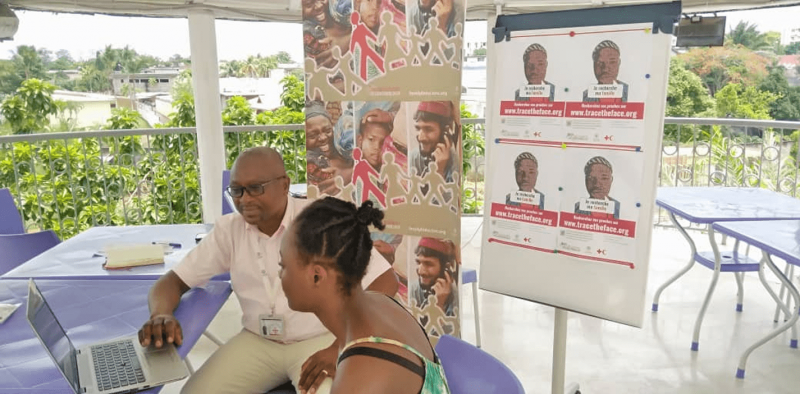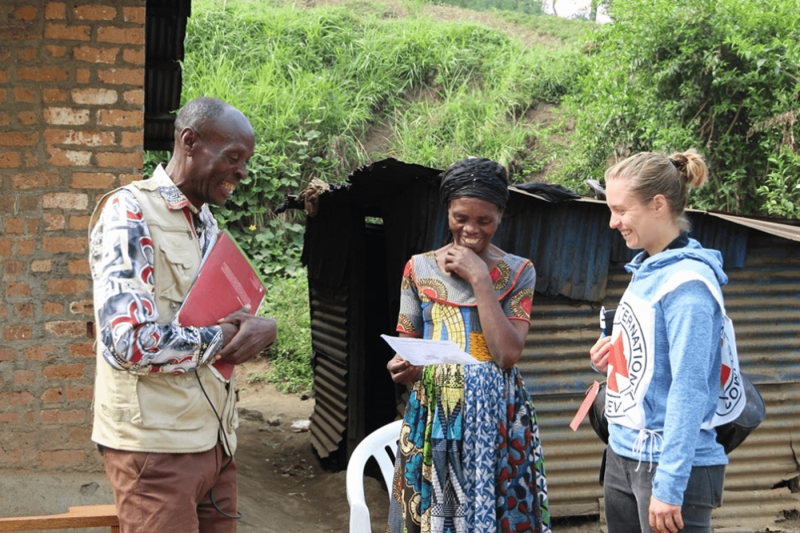Testimonies: How humanitarian technologies impact the lives of affected populations
Digital technologies are changing the very processes we use to serve affected people. In this issue, the Review has chosen to profile the testimonies of two affected people, based in Côte d'Ivoire and the Democratic Republic of the Congo (DRC), who expressed their opinions on two digitally driven projects by the International Committee of the Red Cross (ICRC); these projects respectively facilitate restoring and maintaining family links.1 Being of the view that affected people should speak for themselves and that their testimonies should not be cut down or “reworked” to fit the purposes of humanitarians and their outputs, in this section the Review has directly translated the quotes we received from field delegations, word for word, sentence for sentence, making no changes except for the redaction of information to ensure the extent of anonymity requested. By keeping the framing of the quotes to a minimum, we aim to ensure that the Review serves as a platform for the voices of the featured affected people.
The ICRC's Trace the Face digital platform
The ICRC's Trace the Face digital platform, mentioned by Matty in the following testimony, is a “photo-gallery of people looking for their lost relatives”.2 It is through this site that Matty, based in Abidjan, was able to find her uncle, of whom she'd had no news since the outbreak of the 2010–11 Ivorian crisis.

Matty, in a video call with her uncle; she had not had any news of him since 2011. This call took place on 20 April 2020, after Matty had located her uncle using the Trace the Face site. Photo: ICRC.
The testimony of Matty, based in Côte d'Ivoire, who found her uncle after nine years, using the Trace the Face site
I live with my friends. …3 My mother and father are no longer alive. … My mother died in 2002, following the first crisis. … I was taken in by my uncle, my mother's brother. When I was a baby, my uncle told me that his sister, my mother, had entrusted him to take care of me, and so he took care of me before the crisis separated us in 2011. When the crisis started, everyone was running. This is how he ended up fleeing and I was left behind. I lived in the streets. People picked me up. My friends told me that I could come and live with them. … I didn't want to clutter them too much. …
One day, I was talking to a friend and I was telling him about my situation. He told me that we could go to the Red Cross to see if they could help me find my uncle. We left for the Red Cross headquarters in Plateau. The gentleman who received us took notes. He listened to my story. He said he was going to call me back. And if he didn't call me back, I should call him back. I went back to see him, as he hadn't reached out. He told me he was busy because of the coronavirus crisis. It had just started here. … So, I was waiting. That's when another friend told me that the Red Cross has a website where I can find my uncle by his picture. We went to the cyber café together to do some research. We searched the list. This is how I recognized my uncle. … I wrote under his photo. And that's how the gentleman from the ICRC came to find me. And we exchanged. Then we kept in touch and that's how one day he told me I was going to talk to my uncle. And that's how we ended up here [at the ICRC regional delegation in Abidjan] to talk. I felt abandoned, but here I am happy. I don't know how to describe my emotion. I am filled with joy.
What do you think of the Trace the Face platform?
Tracing the face is a good thing because it allowed me to find my uncle who I was looking for. Tracing the face is good, but it is not too well known. You have to advertise on television, on radios, and display the photos everywhere. Everyone will see and everyone will be able to speak to those who are looking for their parents. You should also make it easier to use so that those who cannot use a computer can easily access the photos and be able to respond without having to ask others for help, who must know our problem first.
The ICRC's Electronic Red Cross Messaging system
The Electronic Red Cross Messaging (ERCM) system is an innovation pilot launched by the ICRC in Rwanda and the DRC. The principal aim is to test whether transforming the paper-based Red Cross messages into an electronic format using tablets and smartphones can reduce transmission times.
The pilot successfully demonstrated proof of concept and recently concluded with promising results. Discussions are currently under way to determine the feasibility of rolling out the ERCM initiative to additional contexts while considering a range of technical, programmatic and data protection questions.

The testimony of Zawadi, a mother based in Rwanda, who was connected with her family through the ICRC's ERCM system
We had already lost them; we thought they were already dead. We are surprised to see their photos; we are very happy. This is my husband's nephew – he left with his mom when he was 6 years old. Now in the post they say he already has two children. I had seen this Red Cross volunteer pass by; they were writing messages in the villages, so I also decided to write to get news. When the war came, the nationals of Rwanda were asked to return home – we thought they were already dead when they left. Now that we have just received their letter, we are really happy with the Red Cross with this letter writing job. He wrote to me that they are still alive, that they were not dead, that his mother is alive, and that he is already married but that his father was already deceased. They were gone while I was still a girl; now I have seven children, you can imagine. I'm going to write to them and send the photos of my children, and I will ask them to send me the photos of their children. I am very happy. I am also happy with you for this model of writing letters that go far. I am proud of you – you're doing a good job. It is very important to study. If I had the money, I could educate all my children. Everything you do is due to education; if someone is not educated they cannot do this job.
What do you think of the ERCM project?
It is a really good project that allowed me to make sure that the members of my family, who I thought were dead, are still alive. I'm now in contact with them thanks to the response to my electronic Red Cross message, which had my phone number. Now, me and my children can talk to our relatives without a problem and share updates. I wish that the project can continue and be useful to others as it was for me because I think that maybe other people could benefit from the project. With the ERCM, I was able to see the current photos of my relatives – my mother and brothers.
What was the impact of the ERCM project on your life?
The project changed my life. … It felt valuable to have been connected with my family. [After finding our family members], my husband … even promised to organize a visit to Rwanda for the official delivery of my dowry to my family. This could not be possible until we heard news of his family members – his mother and brothers. This project has lifted my spirits; I'm very happy and have even gained weight because of the joy.
- 1For humanitarian innovation to be effective and accountable to affected people, these efforts go hand in hand with processes to minimize digital risks and include affected populations as part of the process. For more information on digital risks, see “Q&A: Humanitarian Operations, the Spread of Harmful Information and Data Protection” and the “Reports” section in this issue of the Review.
- 2See ICRC, “What Is Trace the Face?”, available at: https://familylinks.icrc.org/europe/en/Pages/home.aspx.
- 3Throughout these testimonies, ellipses are used to redact identifying information.
